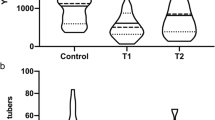Abstract
Phytic acid, saponin and polyphenol contents in grains of various varieties of black gram (Vigna mungo) Mung bean (Vigna radiata L.) amphidiploids ranged from 697 to 750, 2746 to 2972 and 702 to 783 mg/100 g, respectively. Domestic processing and cooking methods including soaking, ordinary and pressure cooking of soaked and unsoaked seeds, and sprouting significantly lowered phytic acid, saponin and polyphenol contents of the amphidiploid seeds. Soaking for 18 h removed 31 to 37% of the phytic acid; the extent of removal was higher with long periods of soaking. Saponins and polyphenols were relatively less affected. Loss of the antinutrients was greater when soaked instead of unsoaked seeds were cooked. Pressure cooking had a greater effect than ordinary cooking. Antinutrient concentrations declined following sprouting; the longer the period of germination the greater was the reduction.
Similar content being viewed by others
References
Elias LG, Colindres R, Bressani R (1964) The nutritive value of eight varieties of cowpea (Vigna sinensis). J Food Sci 29: 118–122.
Salunkhe DK (1982) Legumes in human nutrition. Curr Sci 51: 387–394
Smartt J, Nazmul Haq (1972) Fertility and segregation of the amphidiploidPhaseolus vulgaris L. ×P. coccineus L. and behaviour of back crosses. Euphytica 21: 496
Davies NT, Reid H (1979) An evaluation of phytate, zinc, copper, iron and managanese content of, and availability from soya based textured vegetable protein meat substitute or meat extenders. Brit J Nutr 41: 579–589
Gestetner B, Birk Y, Bondi A, Tencer Y (1966) Method for determination of sapogenin and saponin contents in soyabean. Phytochem 5: 803–806
Singh U, Jambunathan R (1981) Studies of Desi and Kabuli chickpea (Cicer arietinum L.) cultivars: Levels of protease inhibitor, level of polyphenolic compounds and in vitro digestibility. J Food Sci 46: 1364–1367
Swain T, Hills WE (1959) The phenolic constituents ofPrunus domestic L. The quantitative analysis of phenolic constituents. J Sci Food Agric 10: 63–68
Snedecor GW, Cochran WG (1967) Statistical Methods. Oxford and IBH Publishing Co., New Delhi, India
Jood S, Chauhan BM, Kapoor AC (1986) Saponin content of chickpea and blackgram: varietal differences and effects of processing and cooking methods. J Sci Food Agric 37: 1121–1124
Khokhar S, Chauhan BM (1986) Antinutritional factors in moth bean (Vigna aconitifolia): varietal differences and effects of methods of domestic processing and cooking. J Food Sci 51: 591–594
Ologhobo AD, Fetuga BL (1984) Distribution of phosphorus and phytate in some Nigerian varieties of legumes and some effects of processing. J Food Sci 49: 199–201
Kataria A, Chauhan BM, Gandhi S (1988) Effect of domestic processing and cooking on the antinutrients of black gram. Food Chem 30: 149–156
Jood S, Chauhan BM, Kapoor AC (1987) Polyphenols of chickpea and blackgram as affected by domestic processing and cooking methods. J Sci Food Agric 39: 145–150
Kumar KG, Venkataraman LV, Jaya TV, Krishnamurthy KS (1978) Cooking characteristics of some germinated legumes. Changes in phytins, Ca++, Mg++ and pectins. J Food Sci 43: 85–88
Iyer V, Salunkhe DK, Sathe SK, Rockland LB (1980) Quick cooking beans (P. vulgaris L.) II Phytate, oligosaccharides and antienzymes. Plant Foods Human Nutr 30: 45–46
Borade VP, Kadam SS, Salunkhe DK (1984) Changes in phytate phosphorus and minerals during germination and cooking of horse gram and moth bean. Plant Foods Human Nutr 34: 151–154
Satwadhar PN, Kadam SS, Salunkhe DK (1981) Effect of germination and cooking on polyphenols and in vitro protein digestibility of horse gram and moth bean. Plant Foods Human Nutr 31: 71–76
Barroga CF, Laurena AC, Mendona CMT (1985) Polyphenols in Mung bean (Vigna radiata (L) Wilczek). Determination and removal. J Agric Food Chem 33: 1006–1009
Ekpenyong TE (1985) Effect of cooking on polyphenolic content of some Nigerian legumes and cereals. Nutr Rep Intr 31: 561–565
Eskin NAM, Wiebe S (1983) Changes in phytase activity and phytate during germination of two faba bean cultivars. J Food Sci 48: 270–271
Mandal NC, Burman S, Biswas BB (1972) Isolation, purification and characterisation of phytase from germinating Mung beans. Phytochem 11: 495–502
Rao PU, Deosthale YG (1982) Tannin content of pulses: Varietal differences, and effects of germination and cooking. J Sci Food Agric 33; 1013–1016
Kataria A, Chauhan BM, Punia D (1989) Anti-nutrients and protein digestibility (in vitro) of Mung bean as affected by domestic processing and cooking. Food Chem 32: 9–17
Author information
Authors and Affiliations
Rights and permissions
About this article
Cite this article
Kataria, A., Chauhan, B.M. & Punia, D. Antinutrients in amphidiploids (black gram × mung bean): varietal differences and effect of domestic processing and cooking. Plant Food Hum Nutr 39, 257–266 (1989). https://doi.org/10.1007/BF01091936
Issue Date:
DOI: https://doi.org/10.1007/BF01091936




